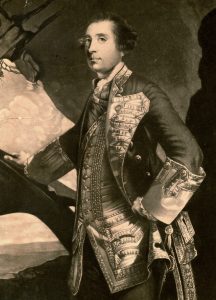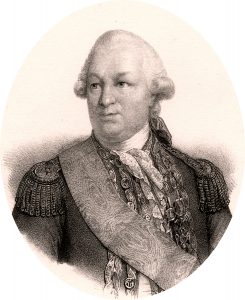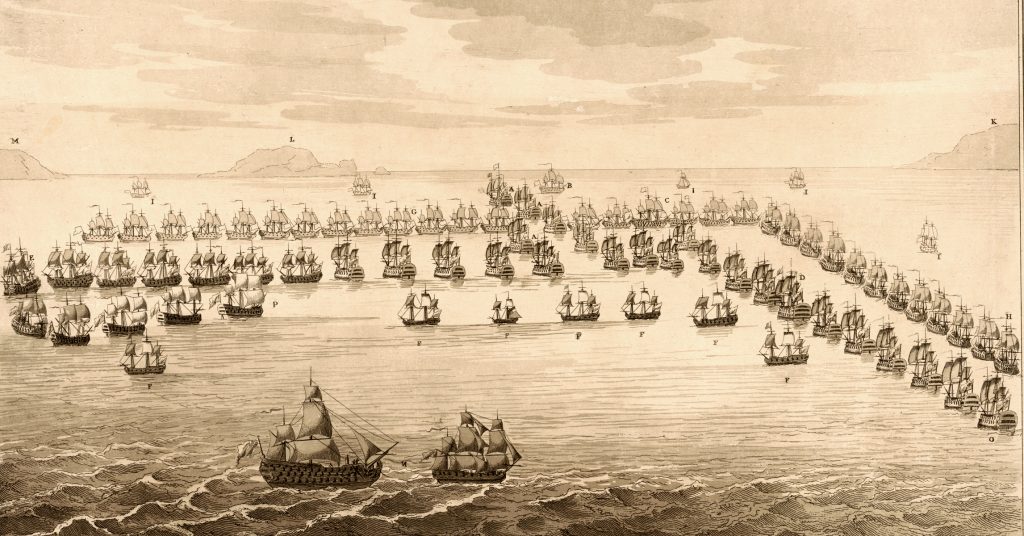We often think that the Siege of Yorktown, Virginia, and the surrender ceremony of October 19, 1781, was the effective end to fighting in the American Revolution. There were smaller skirmishes in isolated places, and some fights, but the two main armies never fought again. Yet the surrender allowed the French navy to return to its base in the Caribbean, where they resupplied and waited for an expected response by the British navy.
On October 5, 1781, two British warships, St. Albans and Eurydice, weighed anchor in Cork, Ireland. Fifty seven merchant ships did the same, and a fair breeze took them out to sea, one by one. They enjoyed clear weather for a week as the convoy steadily sailed south. Unknown ships appeared in the distance, with sunlight shimmering off white sails, but Eurydice gave chase and they turned out to be merchant ships sailing from Canada to Portugal. After four weeks at sea, the men of St. Albans grew restless: three were caught fighting, another was caught stealing, a third failed to show up for his watch.[1]
The fleet communicated with signal flags so messages could be relayed quickly over distances at sea. But the pattern of flags had to be changed periodically so that an enemy could not learn what these ships would do. Each captain had a chart divided by months and days of the week, a list of flags (St. George’s ensign, the Dutch flag, a blue ensign, a red ensign, the Spanish flag), and a list of places on the ship (mizzen top gallant mast, fore top gallant mast, maintop gallant mast). In some cases, the captain put lights in a square, or a triangle, or an inverted triangle, in place of flags. Each ship had only one chart, to be seen by the captain only, and destroyed if there was a risk of capture.[2]
On November 26, the convoy caught sight of Barbados, and the fleet sailed into Carlisle Bay. It was alive with vessels. A trade ship, Rebecca, arrived December 3; the next day, a packet ship sailed away, taking mail to Britain, as two warships, Ranger and Pegasus, came to port. On December 5, Barfleur (carrying Adm. Samuel Hood) and seventeen other warships sailed into the bay. In the following weeks, Ranger and La Fortune left; Monarch, Champion, and Salamander came and went. Carpenters repaired masts and crewmen practiced loading and firing cannons, repairing the rigging and raising sails. On Christmas Eve, two of St. Albans’s sailors were whipped twelve times each, for stealing.[3]
On January 9, 1782, a French admiral, Francois Claude Armour, marquis de Bouillé, led forty ships to the British held islands of Nevis and St. Kitts—which were separated by just two miles of open sea, and lay three hundred fifty miles north of Barbados. The British governor, Thomas Shirley, sent a plea for help to Admiral Hood with the British fleet in Barbados. Some British trade ships escaped as the French ships fired cannons. Soon after, the French landed on St. Kitts, where civilians from the main town, Basseterre, promised they would not oppose the invaders if, in return, they did not destroy the town or imprison its families. Bouillé agreed to their request. Shirley led his militia to Fort Charles on top of Brimstone Hill, which overlooked Basseterre. When the French followed, African slaves on abandoned plantations attacked isolated groups and captured the marquis’ personal servant, taking him to the fort as prisoner. Bouillé threatened to burn the island’s plantations unless his servant was returned, which soon occurred. Yet the remaining slaves were now free to do as they wished: hiding in the forest, capturing one French artillery officer, and killing another. By January 13, the British abandoned their smaller forts around the island, concentrating on Brimstone Hill.[4]
On January 17, the French took over the Summersall estate, seven hundred yards from the fort, and the British garrison harassed them with cannon fire. By the next day, the French had built entrenchments on the Rawlins estate, also seven hundred yards away, and the day after, French cannons fired on the fort itself. On January 21, the French built entrenchments on the Wells estate, a thousand yards from the fort, and fired mortars and howitzers which could send balls looping high in the air and crash down on the British defenders. A day later, the French moved again, taking over the Burke estate.[5]
Meanwhile, Shirley’s dispatch had been taken to Admiral Hood. On January 24, Brimstone Hill’s defenders saw unusual signals raised among the distant French ships. A few hours later, twenty two British ships—including St. Albans—appeared on the horizon, and the French fleet put out to sea. The opposing sides maneuvered for position. A British officer got to shore and made his way past the French and into the fort, where he found the defenders in good spirits. He left again, and slipped past the French a second time. The next day, the French fired a barrage of cannon shots, which set fire to several buildings in the fort and destroyed the militia’s supply of rum, along with some food, muskets and ammunition. The right flank of the northwest wall was destroyed, and its cannons disabled; the retaining wall on the rear was damaged; another wall had a breach forty feet wide. Shirley called the walls of Fort Charles “little better than clay.” Soon after, men began to desert the fort. The sky was hazy day after day, but once the sun broke through and a clear sky appeared, the defenders hoisted flags telling the British fleet in the harbor that they could not hold out. The British fleet raised its own flags: it was not strong enough to attack the French with success. Hood and his fleet were forced to return to Barbados, and the garrison gave Shirley a petition to surrender, to which he agreed.[6]

While all this happened, British Admiral Sir George Rodney took command of a new ship, Formidable, and a fleet of twelve ships in Britain. A crewman recorded what they carried on board one of the ships sixty barrels of water, three hundred bags of bread, ten barrels of oatmeal, nine bags of cheese, forty barrels of beer, a barrel of wine, a barrel of brandy, and three thousand pounds of beef, among other items. Crewmen from the other ships were just as busy. Rodney sailed from London and took the same route so many ships had taken over a century: down the coast of Europe, farther south along Africa, and finally across the ocean, for weeks, helpless against the possibility of storms. Rodney arrived in Barbados with twelve ships of the line on February 14. Admiral Hood came a few days later with twenty one ships, and three stragglers from Rodney’s fleet showed up soon after. Frigates and sloops cruised around the combined force of thirty six warships.[7]
Yet the governor of Barbados, James Cunninghame, was worried about Danish ships coming into port under flags of truce. There was no reason for neutral nations to use them. Rodney suspected these vessels were loading up on fresh food and sailing to French ports, so he ordered that no Danish ships could leave Barbados until they had a strong British escort, to keep them safe from attack and prevent them from making side trips to enemy ports.[8]

Rodney sailed north on February 25. Only Barbados, St. Lucia, Antigua, and Jamaica were under British control; Jamaica was the richest British possession left and remained an obvious target for the French. Admiral François de Grasse was in Martinique, and although he could not risk attacking Jamaica and leave his other islands unprotected, he could partner with the Spanish in Cuba for a joint attack. It took more than a month for him to organize soldiers and sailors, and collect supplies for the anticipated attack. Rodney waited at St Lucia with thirty six ships; de Grasse had thirty three ships near Martinique. They were separated by forty miles of open water, with ships sailing north and south, spying on each other and reporting back to the commanders. In the meantime, Rodney wrote to de Grasse, saying he had taken over the British fleet and complimenting de Grasse on how quickly he had traded British prisoners captured in French raids. Rodney wrote, “Your Excellency’s humanity in endevouring to mitigate the severities of war and alleviate the misfortune of those brave men who had done their duty to their king and country must meet with my highest concurrence.” In response, de Grasse sent Rodney two chests of liquor, along with mail which he asked be returned to Europe.[9]
On April 9, a deserter from Martinique came to Rodney saying that de Grasse had put men in rowboats, which meant he was getting ready to sail. A day later, a messenger said the French fleet was at full sail. Rodney went aboard Formidable and sent a few ships ahead, and when he was assured it was true he ordered the chase to begin. Both fleets got as far north as Guadeloupe where they approached a collection of small islands called the Îles des Saintes. Admiral Hood took eight ships forward to attack two straggling ships in the French rear. As he did so, de Grasse signaled for fifteen ships to come to the rescue. These French vessels fired from a safe distance more as a warning to Hood than a counterassault, and only two of Hood’s ships were damaged. Two days passed as the British repaired their rigging and the French waited for favorable winds. During this lull two inexperienced French captains allowed their ships to collide with others nearby, and one of these clumsy ships lost its foretopmast and drifted south, toward the British. Admiral de Grasse led his own flagship, Ville de Paris, to protect it, but the helpless vessel collided with Ville de Paris as well. The Admiral had to send three ships of his fleet to Guadeloupe for repairs, so Rodney now had an advantage of thirty six ships to thirty.[10]

At seven o’clock on the morning of April 12, 1782, the wind came and both fleets set sail. The French formed in battle line: one in front of another so they could fire a continued barrage of cannonballs if the British sailed too close. It was standard procedure for fleets to sail in lines parallel to each other, pounding cannonballs at each other until one side was broken. As the two sides progressed a sudden drop in wind caused a gap in the French line. Sir Charles Douglas, captain of Rodney’s flagship, urged him to break formation to split the French fleet. Rodney hesitated. It was a breach of naval instructions to break the line, but the opportunity would not last long, so he agreed. The crew on Formidable hauled down the flag signals for “line ahead” and hoisted those for “close action.” Midshipmen ordered trimmed sails; the ship lurched to starboard. Rodney watched as five more ships followed his lead and sailed between ships in the French fleet. Both fleets tacked in the wind, firing among sparks and clouds of gunpowder smoke. Bullets and cannonballs shredded Formidable while a nearby ship, Prince George, lost its foremast and was taking on water at three feet an hour. Sharks feasted in the reddened seawater whenever a crewman threw a dead body overboard. Yet the French ships suffered just as much, and when they had the chance many captains sailed from the battle. Those which could not escape lowered their flags. Ville de Paris fought on, with her decks on fire and masts, sails, and rigging falling among the remaining crew. Nine hours passed before Rodney gave the signal to break line. Admiral de Grasse had fought as few men would have, and was the last to lower his flag.[11]
[1]Journal of HMS St. Albans, Charles Inglis, Captain, kept by Midshipman James Francis Grant, December 4, 1780 – July 28, 1783, Add. MS 45124, British Library.
[2]Monthly Change in Private Signals for the Use of the Fleet under Command of Sir G. B. Rodney, December 14, 1781, Sir George Brydges Rodney Papers, PRO 30/20/22/10, National Archives of the United Kingdom.
[4]Thomas Shirley to George Germain, February 15, 1782, and Journal of the Siege of Brimstone Hill on the Island of St. Christopher’s, 1782, both in Sir George Brydges Rodney Papers, PRO CO 30/20/21/5, National Archives of the United Kingdom.
[5]Thomas Shirley. Journal of the Siege.
[6]Thomas Shirley. Journal of the Siege; Journal of HMS St. Albans; Engineer’s Report of the State of the Works, Buildings, etc. on Brimstone Hill, February 12, 1782, Sir George Rodney Papers, PRO/CO 30/20/25/5, National Archives of the United Kingdom.
[7]AgamemnonLog Book, CAL/107, and William Spry to his parents, April 14, 1782, AGC/14/8, both in Caird Library, National Maritime Museum, Greenwich, England. The Agamemnon log book uses the term “butt;” I have used “barrel” for clarity.
[8]James Cunninghame to George Rodney, March 3 and March 4, 1782, and George Rodney to James Cunninghame, March 8, 1782, all in George Rodney Letterbook, Naval History Society Collection, New-York Historical Society.
[9]Detailed Account of the Battle of Saintes, U49/F5, Twysden and Twisden Mss., Kent County History and Library Centre, Maidstone, England (attack on Jamaica, and spy ships); George Rodney to Admiral de Grasse, March 6 and March 18, 1782, George Rodney Letterbook, 1781 – 82, Naval History Society Collection, New-York Historical Society (letters and wine).
[10]Original dispatch of Admiral Sir G. B. Rodney of the naval victory over the French, ADL/2/51/2. Caird Library, National Maritime Museum.
[11]French Eyewitness Account of the Battle of Saintes by a mariner serving on the Triomphant, April 25, 1782, HSR/F/3, Caird Library, National Maritime Museum.








2 Comments
Sometimes it’s easy to forget that, from a global perspective, the War for Independence was really just another theater, and a proxy war at that, in the centuries long conflict for global hegemony between France and Great Britain — one that would last nearly another three and a half decades after the surrender at Yorktown.
One of my great x 5 grandfathers (Tristam Hillman) served as a Lieutenant aboard Formidable, apparently at Rodney’s request. He was transferred to the Ville de Paris after its capture and acted as ship’s Master to get the ship back to Port Royal- which they did with difficulty.